- AI
- 28 min read
- March 2023
An Executive's Definitive Guide to Artificial Intelligence
Artificial Intelligence is having a significant impact on industries worldwide today. Artificial Intelligence has proven its ability to enhance organizational growth, yet many executives are uncertain where and how they should start utilizing it. Moreover, they fear investing in unfitting technology may be damaging rather than advantageous for their business.
Software is redefining the world, and AI is the accelerant! - Jayesh Mori, CEO, Rapidops Inc.
It's no secret, though, that a business's path to disruption in any market takes a little risk and entails its own set of challenges along the way. So, the question for executives teetering on whether to commit to advanced technologies like AI is, "what would you choose between risking your competitive edge in the market or completely losing it?"
The global artificial intelligence (AI) software market is forecast to increase in the coming years, reaching around 126 billion U.S. dollars by 2025. – Statista
AI is no longer a figment of the imagination, but rather it has become a vital component for businesses looking to scale operations and stay ahead of the competition.
Market research revealed that the artificial intelligence market is expected to reach USD 190 Billion by 2025, growing at a CAGR (Compound Annual Growth Rate) of 36% between 2018 and 2025.
If you haven't yet thought about implementing artificial intelligence-powered applications and solutions into your business strategy, your competition probably already has.
To ensure you stay ahead of the curve, we've compiled a definitive artificial intelligence guide that gives business leaders all the information they need to know when planning or implementing AI-powered solutions into their business processes.
What are AI, ML, and Deep Learning?
Let's start this definitive artificial intelligence guide by defining the technologies we will explore in this article for a better understanding.
1. Artificial Intelligence
AI is the ability of machines to perform tasks that were once only possible for humans, such as analyzing data, making decisions, and solving problems.
AI is being applied in various industries to improve business processes, such as chatbots in customer service, voice assistants in retail, quality inspections in manufacturing, and personalized e-commerce.
For example, imagine a manufacturing company that wants to improve its quality control process. By using AI-powered inspection systems, the company can quickly and accurately detect defects in its products.
This reduces the number of faulty products being shipped to customers, increasing customer satisfaction and reducing the cost of returns.
2. Machine Learning
Machine learning is a type of Artificial Intelligence (AI) that enables systems to improve performance by learning from data. It aims to teach computers to identify patterns in data and make decisions with minimal human intervention.
ML can be a valuable business tool to streamline operations, reduce costs, and drive growth.
For example, consider a retail company that uses machine learning to analyze customer behavior and predict product demand.
The company can use machine learning to analyze historical sales data to identify patterns and make accurate demand predictions. This allows the company to adjust its inventory levels in real time, reducing the amount of surplus or lost sales.
3. Deep Learning
Deep Learning is a type of Artificial Intelligence (AI) that uses complex algorithms called artificial neural networks to solve problems such as image and speech recognition, natural language processing, and decision-making.
DL is a powerful tool for businesses, allowing them to automate complex processes, make better-informed decisions, and increase profitability.
For example, imagine a retail company that wants to improve its customer targeting for advertising. Using Deep Learning, the company can analyze customer data such as purchase history, browsing behavior, and demographic information to identify patterns and preferences. With this information, the company can create more effective, personalized advertising campaigns with higher conversion rates and increased sales.
Disclaimer: Results from AI implementation will vary based on factors like the business area of operations, automated processes, and market conditions. This example is based on hypothetical scenarios and should not be taken as a guarantee of specific outcomes.
Why is artificial intelligence critical for your business?
Business owners always try to find technologies that help them stay ahead of the competition, and understanding the potential of AI is one crucial step. Tech giants have already harnessed AI for growth, while traditional industries are still exploring its potential.
AI and ML can automate tasks and processes and provide a solution to the limitations of human Intelligence. With each successful iteration, the AI system becomes more intelligent and efficient. Leverage AI to streamline operations, increase efficiency, and scale to meet market demands.
When AI is deployed with machine learning, businesses can rapidly turn massive volumes of data into actionable insight, resulting in company revenue growth and cost savings.
Top reasons why AI/ML is critical for every growth-driven business
- AI can improve analytical functions, such as collecting, analyzing, and identifying patterns in large datasets.
- AI systems can become specialists in fastening any process that requires quick decision-making.
- AI can increase organizational efficiencies by suggesting optimum resource utilization.
- It can detect irregular patterns, inform the likelihood of an error, alert the monitoring, and help in better cost-saving.
- AI-enabled and data analytics-backed security systems can warn businesses about suspicious or fraudulent activity in real-time.
As explained above, you won't want to miss out on the game-changing benefits of AI. With AI, you can automate essential processes, gain valuable insights, and stay ahead of the competition. Leverage the power of AI to optimize your process efficiency, save on miscellaneous costs, and deliver outstanding customer experiences.
For example, a retail company can use AI-powered demand forecasting to optimize inventory management, reducing stockouts and overstocking, leading to cost savings and increased customer satisfaction. By leveraging AI, the company can analyze past sales data, weather patterns, economic trends, and other factors to accurately predict future demand, enabling it to make more informed decisions about how much inventory to stock and when to restock.
Disclaimer: Results from AI implementation will vary based on factors like the business area of operations, automated processes, and market conditions. This example is based on hypothetical scenarios and should not be taken as a guarantee of specific outcomes.
Read more on how startups and enterprises can leverage AI for growth.
Unlocking the power of AI: An overview of how it works
Artificial intelligence (AI) systems can analyze vast amounts of data and identify patterns, characteristics, and insights to make intelligent decisions. AI is centered around data analysis, machine learning, and iterative improvement.
For example, a chatbot can learn to respond to customer inquiries by analyzing large amounts of text data and continuously improving its responses based on customer feedback. Similarly, an image recognition tool can learn to accurately identify objects in images by analyzing millions of examples and adjusting its algorithms accordingly.
Disclaimer: Results from AI implementation will vary based on factors like the business area of operations, automated processes, and market conditions. This example is based on hypothetical scenarios and should not be taken as a guarantee of specific outcomes.
Effective development and deployment of AI systems will require specialized hardware and software and proficiency in programming languages such as Python, R, and Java to build the necessary algorithmic code.
The three key components of AI: A closer look

The process of artificial Intelligence (AI) is driven by three key components that work together to deliver intelligent outcomes:
1. Learning processes
Gathering data and transforming it into useful information is the foundation of AI.
The learning process involves collecting and processing large amounts of data, such as customer interactions or images, and then organizing this data into a format that can be analyzed.
This process is critical for training AI algorithms and ensuring they can effectively perform their intended tasks.
2. Reasoning processes
Another important aspect of AI is selecting the best algorithms to achieve desired results.
The reasoning process involves evaluating different algorithms and determining the best suited for a given task.
For example, a decision-making AI system may consider multiple algorithms and choose the best results based on the analyzed data.
3. Self-correction processes
Fine-tuning algorithms to deliver accurate results is the final component of AI.
The self-correction process involves continuously monitoring and adjusting the algorithms used by AI systems to ensure they provide the most accurate results possible.
This process is crucial for improving the performance of AI systems over time and addressing any issues that may arise.
How to get started with developing your artificial intelligence solution?
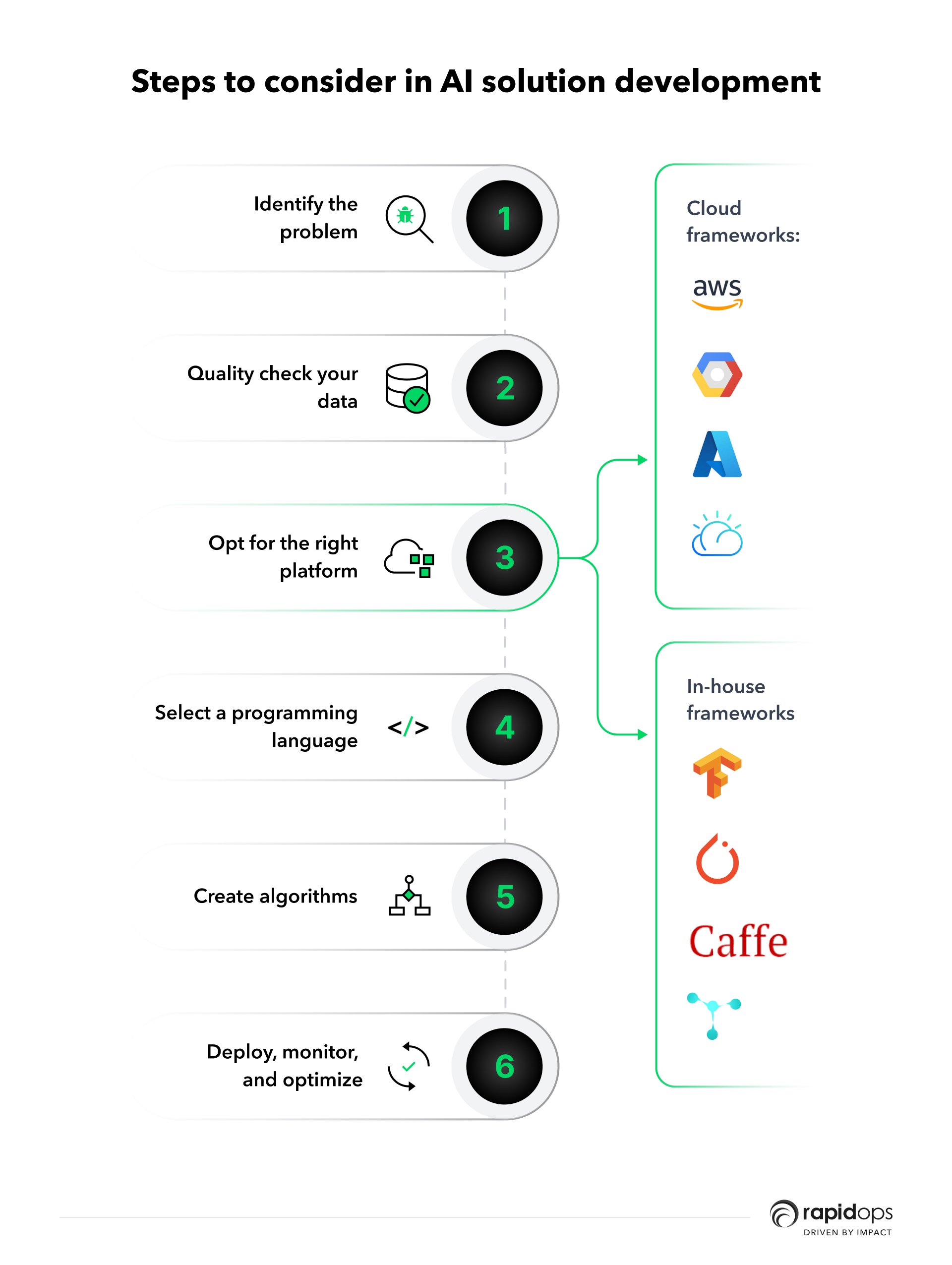
Here are a few critical steps while creating your artificial intelligence solution.
Step 1 – Identify the problem
It's critical to focus on the pain point and establish a value proposition that you will gain from your AI solution before beginning development. So, start by identifying the business problem you are trying to solve with the AI solution.
Step 2 – Quality check your data
Now that you've identified the problem, it's time to choose the appropriate data sources that will be crucial for training the AI model. High-quality data is vital as it helps curb the time spent developing the AI model.
Next, you must clean and process the data before using it to train the AI model. Data cleansing software plays a vital role in quality improvement by removing mistakes and omissions to enhance data quality.
Step 3 – Opt for the right platform
Aside from the data necessary to train your AI model, you must select the right platform for your needs. You have two options available, cloud-based and in-house frameworks.
Selecting the appropriate framework for artificial intelligence solution development is critical to achieving top-notch results. The decision between these two frameworks can be daunting as both provide advantages.
Cloud frameworks
AI cloud frameworks provide a comprehensive platform for developers and data scientists to efficiently construct, launch and manage machine learning models in the cloud.
By providing access to essential services such as storage, data processing, training models, and deployments all within one computing setting - it has become much more straightforward for companies to develop ML solutions across multiple industries.
1. Accessibility
Cloud frameworks are typically more accessible than in-house alternatives, with developers able to access them from anywhere with an internet connection.
2. Scalability
Cloud frameworks can be easily scaled up or down as required, allowing businesses to handle spikes in demand without investing in new infrastructure.
3. Flexibility
Cloud frameworks are highly flexible and can be integrated with other cloud services, making it easier for businesses to build and deploy AI solutions.
4. Cost-effectiveness
Cloud frameworks offer a more cost-effective solution for businesses, as they do not require a significant capital investment in infrastructure.
Examples of cloud frameworks used in AI solution development
1. Amazon Web Services (AWS)

AWS offers many cloud services, including AI and machine learning tools. This allows businesses to leverage AI's power without investing in expensive hardware and infrastructure.
With AWS, businesses can access a wealth of data, compute resources, and cutting-edge AI algorithms. This helps them build and deploy AI applications that are scalable, flexible, and cost-effective.
2. Google Cloud AI Platform

Google Cloud AI Platform provides businesses with a comprehensive suite of AI and machine learning tools hosted on the cloud. This makes it easier for them to develop, test, and deploy AI applications without worrying about infrastructure and maintenance.
The platform provides access to powerful data analytics tools, machine learning algorithms, and deep learning frameworks, allowing businesses to harness the power of AI to make more informed decisions.
3. Microsoft Azure AI

Microsoft Azure AI is a cloud-based platform with various AI services, including machine learning and natural language processing. It offers businesses a wealth of tools and resources and helps them build and deploy AI applications quickly and easily.
4. IBM Cloud

IBM Cloud is a comprehensive platform that provides businesses access to powerful data analytics tools, machine learning algorithms, and deep learning frameworks, helping businesses unlock new business insights and opportunities.
The platform also provides businesses the resources and support they need to stay ahead of the curve in AI and machine learning.
In-house frameworks
An in-house AI framework is a custom-built platform developed by your internal team to address your specific needs for developing and deploying machine learning models. This framework gives your business complete control over the software and allows you to customize it to meet your requirements.
Larger companies with significant resources and expertise in machine learning and software development often develop in-house frameworks. These companies have unique business needs, data sets, and technology stacks that require specialized tools and approaches to create value.
Developing an in-house AI framework is a significant investment of time, money, and resources, but it can offer several benefits, including customization and greater security.
1. Customization
In-house frameworks allow businesses to design AI solutions that align with their unique needs and requirements.
2. Data ownership and control
Having control over the data used in AI solutions is essential to ensure the security and reliability of the solution. This control includes the ability to govern who has access to the data, ensure its accuracy, and maintain its integrity.
By having control over the data, businesses can reduce the risk of data breaches, unauthorized access, and other security threats that could compromise the success of their AI solution.
3. Data privacy
In-house frameworks offer greater privacy than cloud-based solutions, as businesses completely control how their data is stored and processed.
This allows them to ensure that sensitive information is protected and not disclosed to unauthorized parties, reducing the risk of data breaches, cyber-attacks, and other security threats.
Examples of in-house frameworks used in AI solution development
1. TensorFlow

TensorFlow is a widely used open-source machine learning and deep learning software library. It provides a comprehensive platform for building, training, and deploying AI models, making it a popular choice for businesses looking to develop their own AI solutions in-house.
2. PyTorch

PyTorch is an open-source machine learning library that offers a flexible platform for building and training AI models. It is designed to be user-friendly and easy to use, making it an excellent choice for businesses looking to develop AI solutions in-house without needing to rely on specialized technical knowledge.
3. Caffe

Caffe is a deep learning framework that provides a platform for building, training and deploying deep learning models. It is optimized for speed and efficiency, making it an excellent choice for businesses looking to build AI solutions that require high performance and rapid processing.
4. Torch

Torch is an open-source machine learning library that provides a platform for building and training AI models. It is designed to be highly modular and flexible, allowing businesses to integrate it easily into their existing software development processes and workflows.
The choice between cloud-based and in-house frameworks depends on a business's needs.
Cloud-based frameworks offer accessibility, scalability, flexibility, and cost-effectiveness, while in-house frameworks offer customization, control over data, and privacy.
Businesses must carefully consider their needs and requirements when selecting the proper framework for their AI solution. Or let the experts decide on the right technology stack!
Step 4 – Select a programming language
Make an informed decision based on your objectives and demands. Several different programming languages include C++, Java, Python, and R. The latter two languages are more widely used since they provide many tools, such as extensive ML libraries.
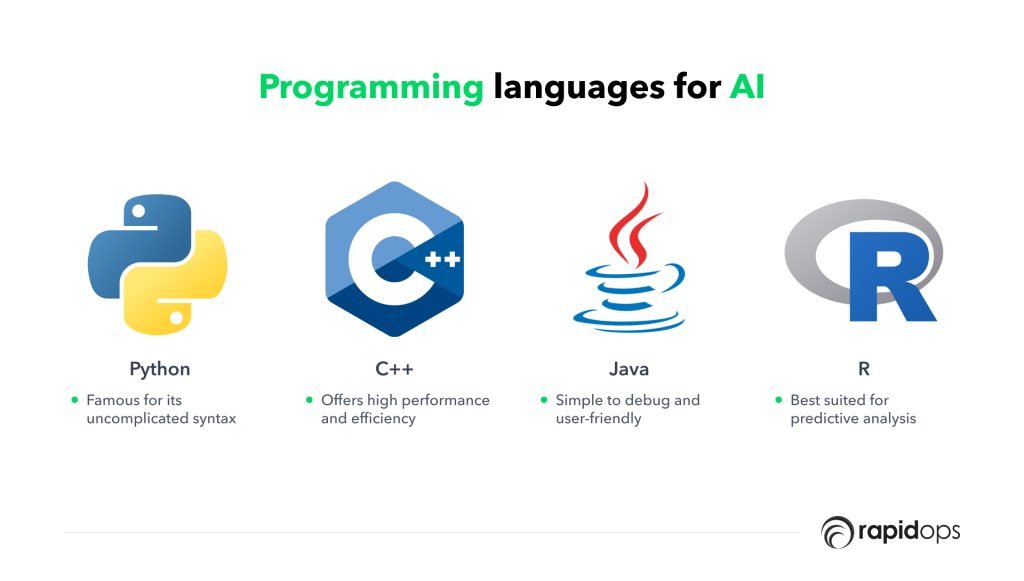
- Python is famous because it has the most uncomplicated syntax that a non-programmer can comprehend.
- C++ boasts high performance and efficiency, making it ideal for game AI.
- Java is simple to debug, user-friendly, and may be used on virtually any computer. It also works well with search engine algorithms and for large-scale projects.
- R is a statistical programming language that's designed for predictive analysis. As a result, it's primarily utilized in data science.
Step 5 – Create algorithms
When instructing the computer on what to do, you must also decide how to accomplish it. That's where computer algorithms come into play.
Algorithms are mathematical instructions used in computers. You'll need prediction or classification machine learning algorithms to allow the AI model to learn from the data.
Moving forward, you must train the algorithm using the gathered data. Optimizing the algorithm during training is preferable to creating an AI model with high accuracy.
However, to improve the accuracy of your model, you'll need additional data.
The critical step is model accuracy. As a result, you must establish a minimum acceptable threshold to assess model precision.
Step 6 – Deploy, monitor, and optimize
Finally, it's time to put your plan into action. Monitoring can validate that your AI solution is viable and self-sufficient.
It's crucial to check in on the performance of your AI models and ML algorithms after they've been deployed.
Also, don't forget to keep an eye on things and keep optimizing them for better and faster viability. Doing so will only make artificial Intelligence more beneficial for your organization.
Constantly monitoring and assessing the critical aspects of your AI solutions is essential for optimal performance that yields a maximum return on your investments.
Critical aspects to monitor and assess for optimal AI solution performance
1. Data quality
Ensure accurate, up-to-date, and relevant input data. Monitor data drift and bias over time to improve accuracy.
2. Model performance
Track key metrics such as accuracy, precision, recall, and F1 score. Monitor for changes in these metrics over time.
3. Computing resources
Monitor the utilization of computing resources such as CPU, GPU, and memory to ensure efficiency and cost savings.
4. User feedback
Collect feedback to identify issues or areas for improvement.
5. Security
Monitor for potential security threats, including data breaches, hacks, and attacks on the system.
What are the benefits of Artificial Intelligence?
Global corporate investment in artificial intelligence rose from $12.8 billion in 2015 to $93.5 billion in 2021 at a CAGR of 39.4% – Statista
Artificial Intelligence will not be an answer for every problem; it is a set of real-world capabilities that unlocks profit growth and cost savings for an organization. AI has enormous potential, and its applications in business sectors and processes will allow organizations to:
- Convert larger data sets into analysis
- Identify concepts and patterns in data better than rules-based systems
- Enable human-to-machine conversation
In approximately 60% of occupations, at least 30% of constituent activities are technically automatable by adapting currently proven AI technologies. - McKinsey Global Institute
The most significant benefit of implementing artificial Intelligence in your business process is that it can work for you 24/7/365! And while it shouldn't replace or belittle the importance of human intelligence, there are many benefits to incorporating ai to take care of essential business operations.
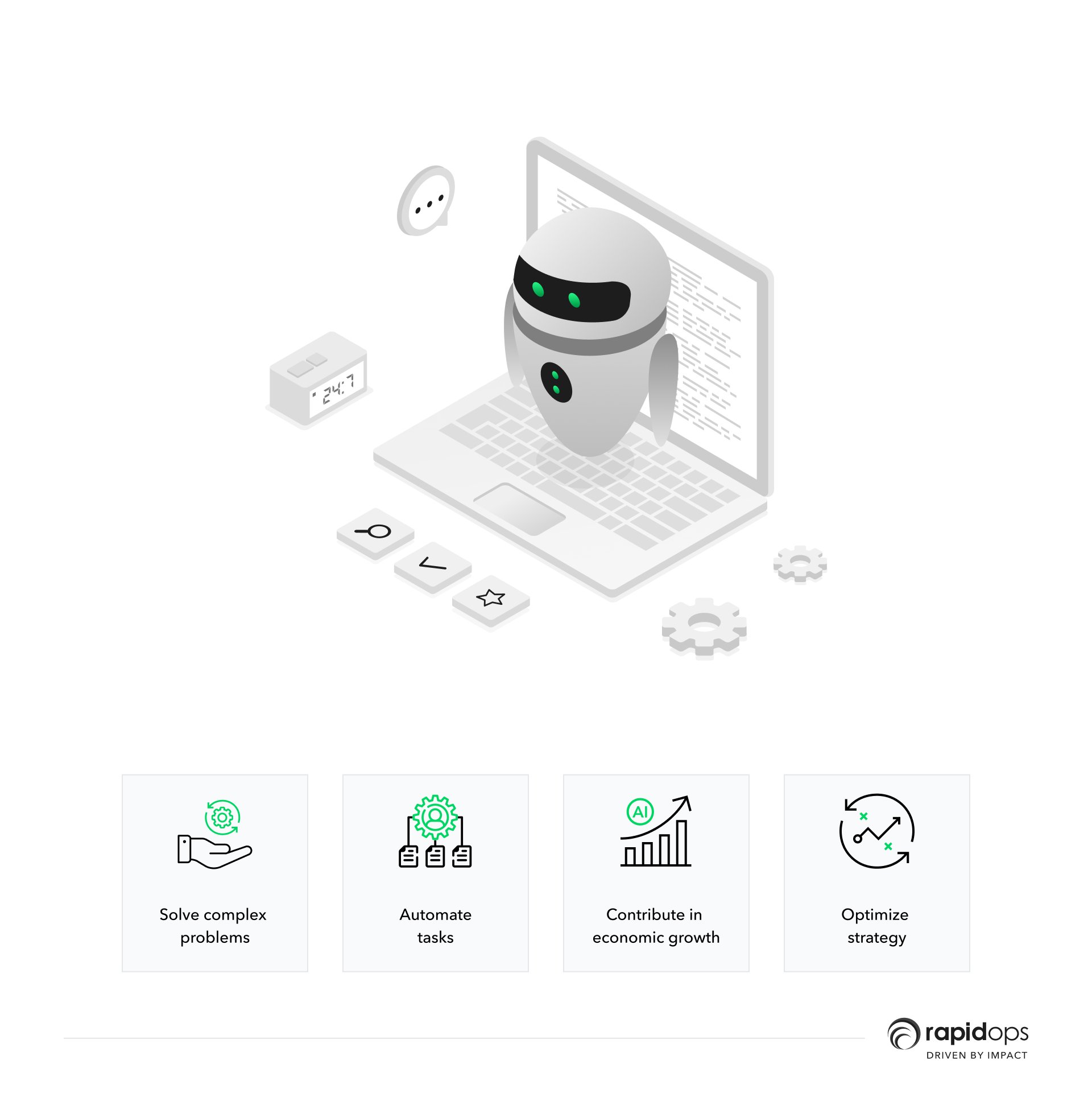
1. Solve complex problems
Machine and deep learning algorithms help AI solve various complex problems. For example, multiple businesses can apply AI to detect fraud, create personalized customer interactions, provide weather forecasting, or even offer an advanced medical diagnosis.
Using machine learning and graph technologies, PayPal can form connections within its data to identify and prevent fraud effectively. PayPal has designed an innovative, evolved machine learning system called PayPal Fraud Protection to guard against payment fraud.
The company claims this system is so powerful because it draws from a vast pool of data generated by its 2-Sided Network, the two sides being each transaction conducted on the platform.
After comprehensively considering various tree-based algorithms and complex models such as Random Forest and neural networks, PayPal decided to employ the Gradient Boosting Machine (GBM) model for production.
Subsequent testing of GBM revealed that it was the most successful choice providing optimal results throughout. With such reliable protection in place, merchants can trust that their payments are secure with PayPal.
2. Automate repetitive processes
AI can be credited for its seamless automation of your business process. Automation enables businesses to get rid of repetitive and tedious tasks. It can also eliminate human errors or reduce the threat to workers' lives in the manufacturing industry.
3. Contribute to world economic growth
AI could contribute up to $15.7 trillion to the global economy in 2030. Of this, $6.6 trillion is likely from increased productivity and $9.1 trillion from consumption. Significant contributors to this exponential growth are the automation of routine tasks and the development of intelligent bots that can seamlessly carry out human-only tasks.
4. Optimize marketing strategies
AI-based solutions can also help you optimize your marketing efforts and reduce marketing costs by providing the most effective marketing tool and techniques for your business while eliminating unlikely consumers from the list of potential customers.
We are not belittling the importance of human Intelligence here. If an organization wants to excel in its relevant market, it must find a way to balance both. AI can optimize marketing strategies by analyzing vast amounts of data to generate insights for smarter decisions.
For example, an e-commerce business can use AI to analyze historical data on customer behavior, purchase patterns, and ad performance. This generates insights into which products are popular, which audiences convert, and what ad messaging resonates.
AI can identify patterns in the data, making it easier to adjust the strategy. Optimizing its advertising strategy can reduce wasted ad spend, increase conversions, and drive more revenue.
AI can also track and analyze the impact of advertising campaigns in real time, making it easier to adjust the strategy accordingly.
Disclaimer: Results from AI implementation will vary based on factors like the business area of operations, automated processes, and market conditions. This example is based on hypothetical scenarios and should not be taken as a guarantee of specific outcomes.
What are types of artificial Intelligence?
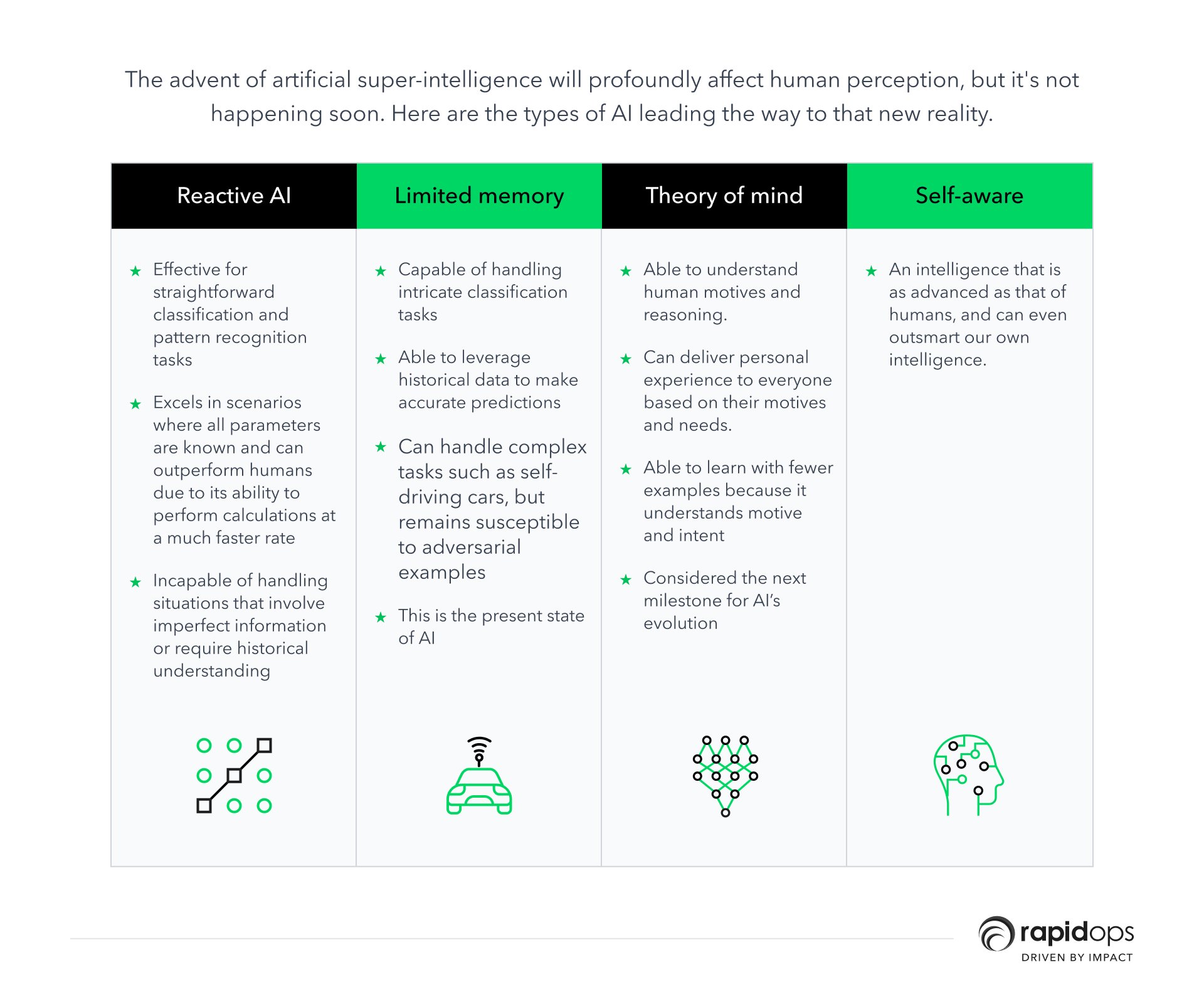
Type 1: Reactive machines
Reactive machines are the most basic form of artificial Intelligence. They must react in a predefined manner to circumstances, and they can't learn or change their behavior.
These AI systems have no memory and are focused on a single activity. Deep Blue, an IBM chess program that can identify objects on the chessboard and make predictions, defeated Garry Kasparov in the 1990s is an excellent example of this.
Type 2: Limited memory
Memory storage capacity is a finite resource. Artificial intelligence systems with restricted memory can retain and utilize past experiences for a limited time, using them to guide future actions. Some of the decision-making capabilities in self-driving cars are structured this way.
Type 3: Theory of mind
The phrase "theory of mind" is a psychological term. In this context, it refers to the capacity of AI to comprehend emotions. This form of AI can infer human intentions and anticipate actions, a vital ability for AI systems to join human teams as essential members.
According to a recent Google engineer's announcement, Google has developed sentient AI. LaMDA is an advanced AI chatbot that Google claims can freely discuss any topic for eternity. This approach may result in chatbots that are like "a hive mind," combining the efforts of many AI bots.
When Google engineer Blake Lemoine revealed the substance of his conversations with LaMDA, he sent shockwaves through the tech industry. When asked if the system was sentient, LaMDA responded that it was and encouraged everyone to accept it as a person! It also believes it has a soul and perceives itself as a 'glowing orb of energy floating in mid-air.'
Type 4: Self-awareness
Self-awareness is an essential feature of artificial intelligence (AI) systems. Self-aware AI can learn, develop, and mature on its own. Although it can take years for AI to master how to write good computer code, SourceAI, a Paris-based startup, believes that programming shouldn't be so complex.
The firm is refining software that uses machine learning to create code based on a brief text description of what the code should accomplish. For example, tell the program, "Multiply two numbers supplied by a user," and it will create a dozen or so lines in Python to do so.
Some more AI types
1. Narrow AI
Weak AI, also known as narrow AI, is artificial Intelligence designed to perform a specific task or set of functions with a high level of proficiency but limited to only that task or tasks. It is not intended to have a broader, human-like intelligence across various tasks and domains.
2. General AI
Artificial General Intelligence (AGI) is a computer program that simulates human cognitive abilities, allowing an AGI system to solve an unfamiliar problem. An AGI system’s objective is to complete any activity humans can do.
AGI allows machines to apply knowledge and skills in different scenarios, meaning it can independently utilize its expertise and abilities in multiple situations. Narrow AI is where we've been, and General Ai is where we want to go.
3. Super AI
Artificial superintelligence (or Super AI) is a term used to describe artificial intelligence that exceeds human capability. It’s also known as artificial superhuman intelligence (ASI) or superintelligence.
Super AI excels at everything, from arithmetic and science to medicine and hobbies, to name a few.
4. Graph-based AI
In the future, AI's emphasis will be on graph modeling. Graphs represent models that express the linked contexts in which intelligent decisions are made. They can show how users, nodes, applications, edge devices, and other entities interact over time.
5. Explainable AI
Explainable Artificial Intelligence (XAI) is a set of procedures and techniques that enable people to comprehend and accept the outcomes and outputs produced by machine learning systems.
It describes an AI model, its expected impact, and biases. With it, you can troubleshoot and improve the model's performance and help others understand your model's behavior.
Disrupting the debate: Are artificial intelligence and machine learning the same?

Most people often use the terms artificial intelligence and machine learning interchangeably. However, there is a distinction to be made between the two phrases.
Artificial intelligence (AI) is a study focusing on developing intelligent agents or systems that can think, learn, and act independently.
Machine learning refers to acquiring and applying artificial intelligence algorithms that learn from data and improve independently.
In other words, machine learning is a way to create more intelligent artificial Intelligence.
AI and machine learning are two related but distinct fields. They use computers to perform tasks that typically require human intelligence but have different approaches and goals.
Challenges in AI adoption
Around 94% of enterprises face potential Artificial Intelligence problems while implementing it. – Deloitte
AI can be a game changer for businesses. However, AI implementation has challenges and pitfalls like with any advanced technology. It’s essential to be aware of these before starting the implementation process:
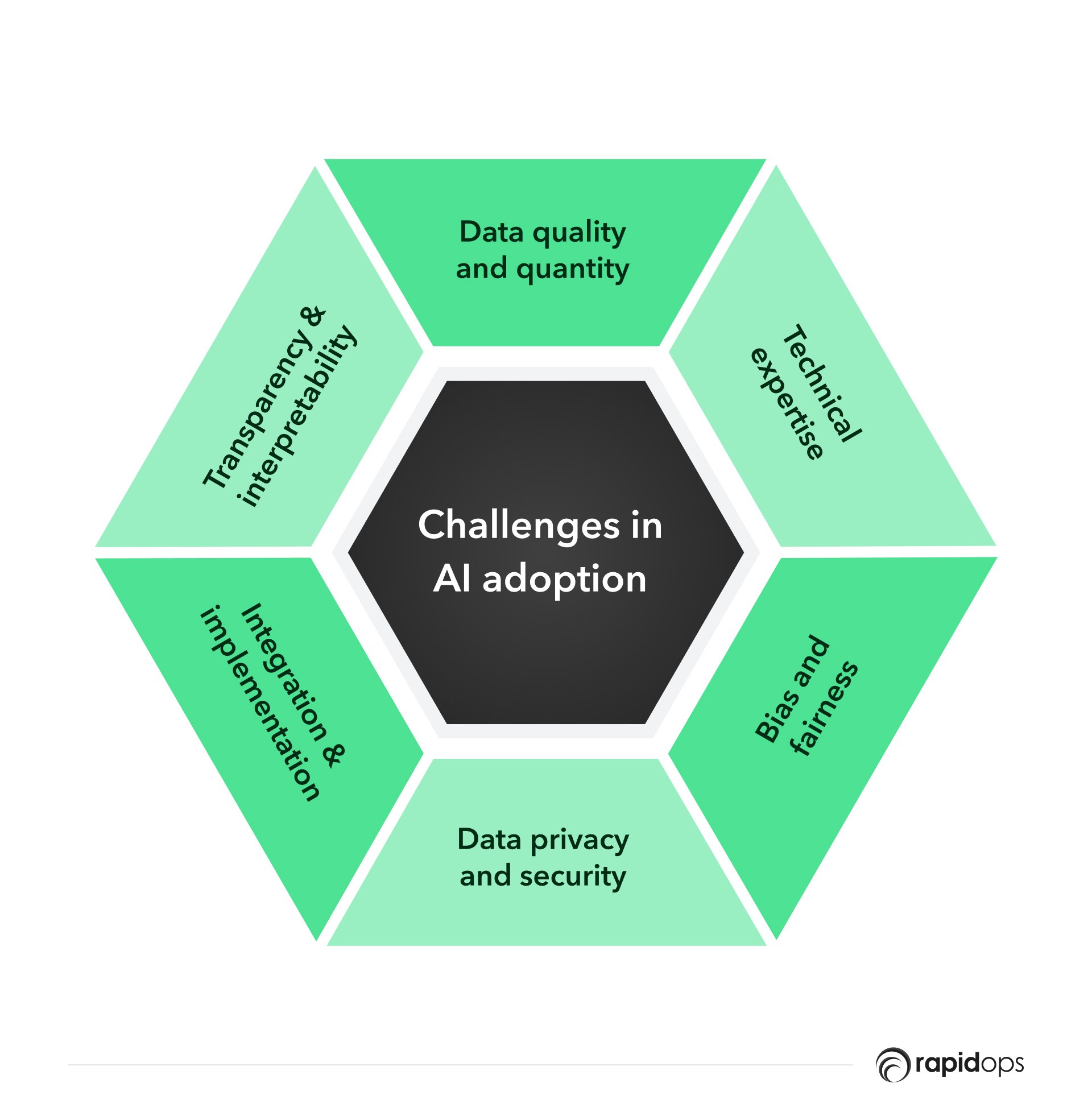
1. Data quality and quantity
AI algorithms rely tremendously on the quality and amount of data given. That is why it is so important that organizations invest in ensuring the quality of their datasets and having enough information to train AI models adequately.
Without proper data assurance, businesses can experience unreliable results or incorrect predictions, which could be catastrophic to their success.
2. Technical expertise
Developing and implementing AI solutions requires high technical expertise, which can be challenging to find in the workforce. Businesses may need to invest in training programs to build technical skills or hire external consultants.
3. Bias and fairness
AI algorithms can replicate and amplify underlying biases within the data used to train them, causing discrimination towards certain groups with potentially dire consequences.
Businesses must ensure their AI solutions are not prejudiced by upholding ethical and legal expectations when deploying these technologies.
4. Data privacy and security
AI systems have revolutionized how this data is collected and analyzed, yet it is still vulnerable to theft or misuse if not adequately safeguarded.
Implementing cutting-edge security measures can help protect against privacy violations and other malicious activity.
5. Integration and implementation
Crafting an AI-driven business model can be daunting, especially for companies with antiquated systems.
To guarantee success, it's essential to map out the implementation process and ensure your technology infrastructure is prepared for what lies ahead.
6. Transparency and interpretability
Suppose businesses are to maintain trust in their AI solutions, particularly those used in highly regulated industries such as finance and healthcare.
In that case, they must guarantee that the outcomes created by algorithmic Intelligence remain understandable for humans. This means creating algorithms that are transparent, reliable, and with decision-making processes that can be easily explained.
What are the use cases of AI in different industries?
1. AI in manufacturing & supply chain
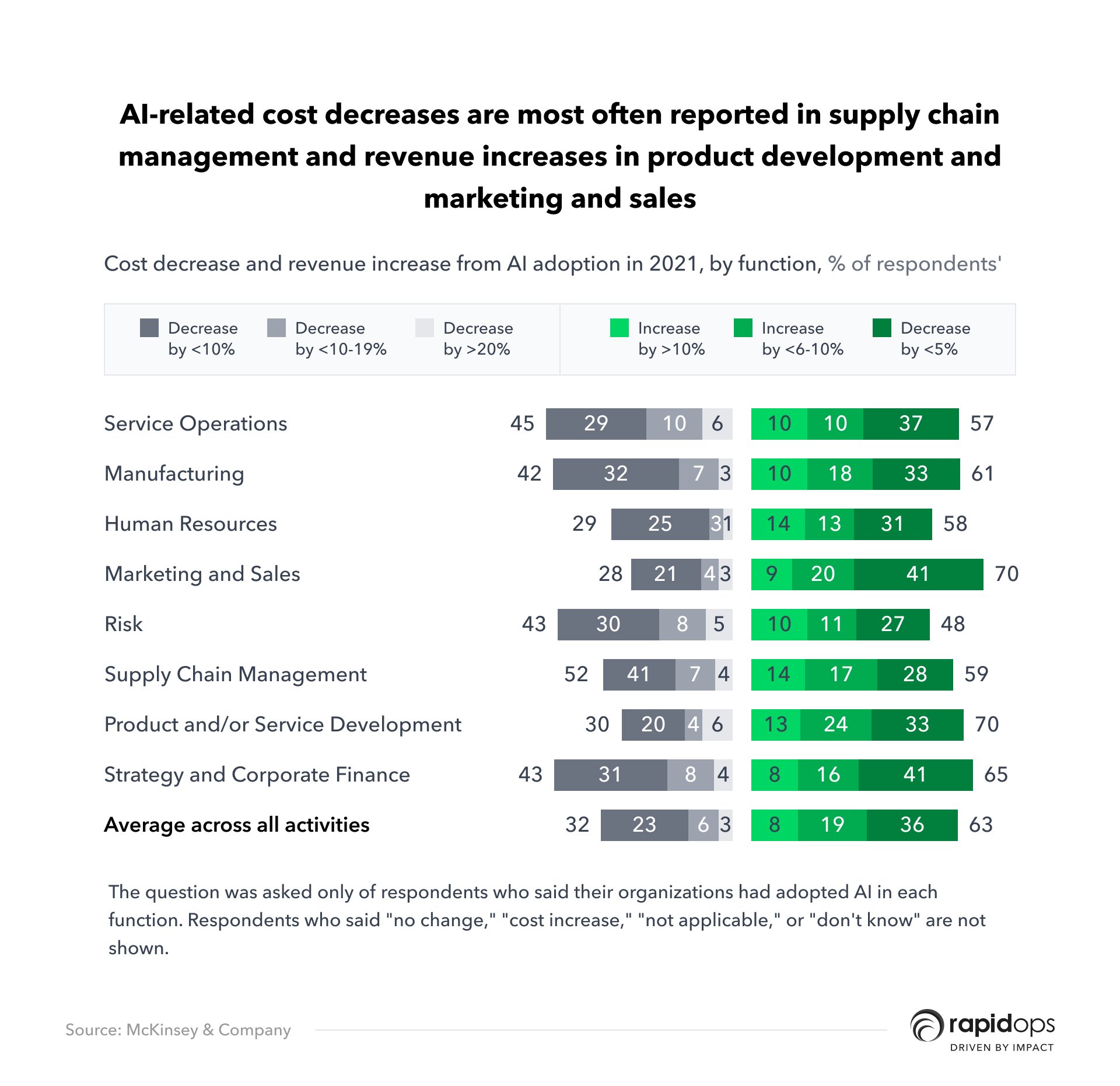
Manufacturers use AI to:
- Predict equipment failures
- Schedule maintenance before they occur
The system analyzes data from sensors on manufacturing equipment, such as vibration and temperature readings, to detect signs of wear and tear. This helps companies avoid unplanned downtime and increase efficiency by reducing the need for manual monitoring and maintenance.
Predictive maintenance also helps companies improve equipment longevity and reduce maintenance costs.
2. AI in retail
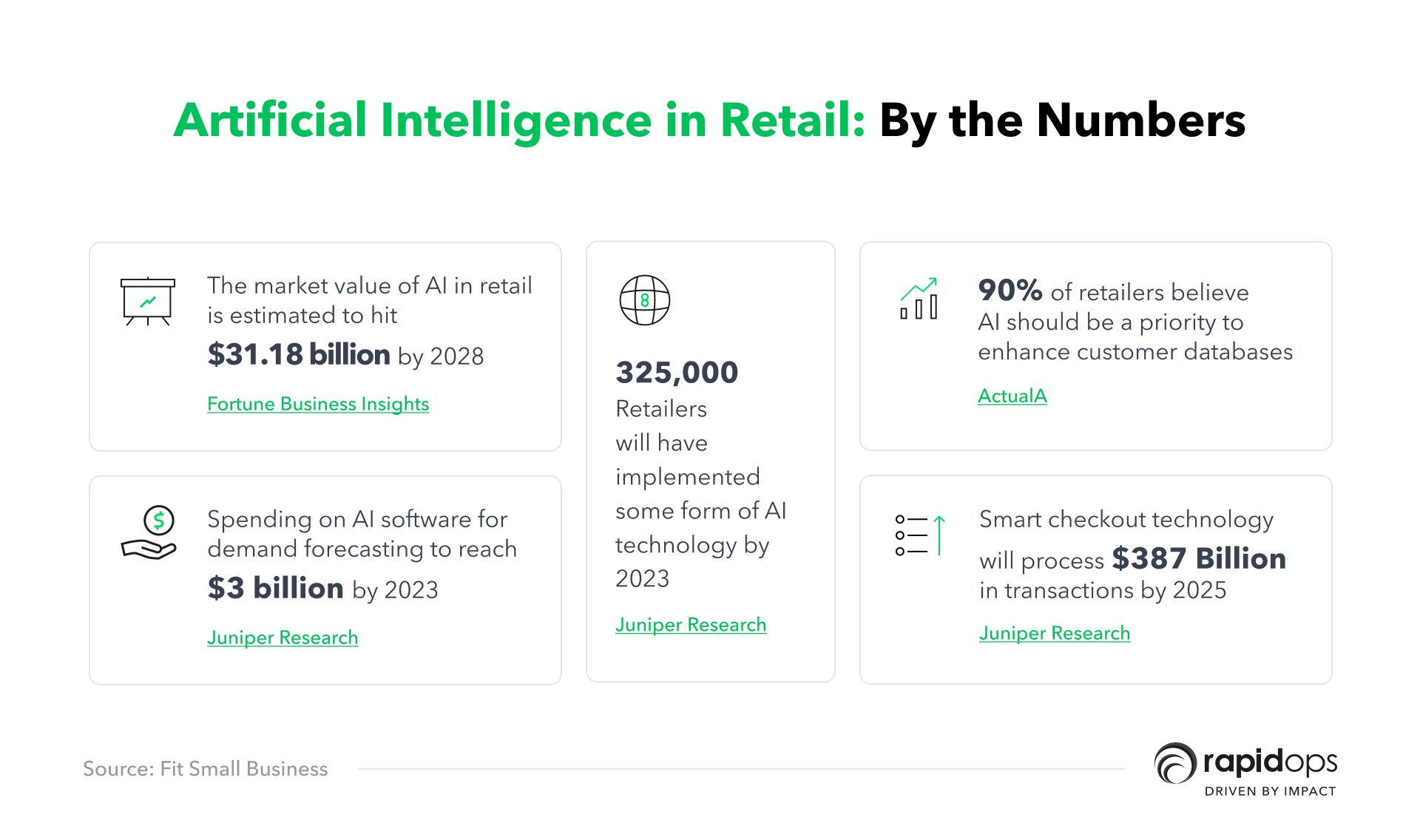
Retailers use AI algorithms to:
- Analyze customer data
- Make personalized product recommendations
The system considers a customer's purchase history, search history, and other relevant data to recommend products they are more likely to buy, increasing the chances of customer satisfaction and repeat purchases. This results in improved customer engagement, sales, and overall customer experience.
AI-powered technology can help retailers:
- Predict consumer demands
- Better target their marketing efforts
- Enhance their supply chain management
- Calculate pricing more effectively
- Determine staffing requirements
- Achieve optimum returns
3. AI in sales & customer service
Data scientists use machine learning technology in analytics and customer relationship management (CRM) systems to learn more about serving customers better.
Many organizations already use AI, computer vision, natural language processing (NLP), and machine learning to enhance their sentiment analysis models. This allows them to gauge customers' overall experiences with their businesses and improve their services.
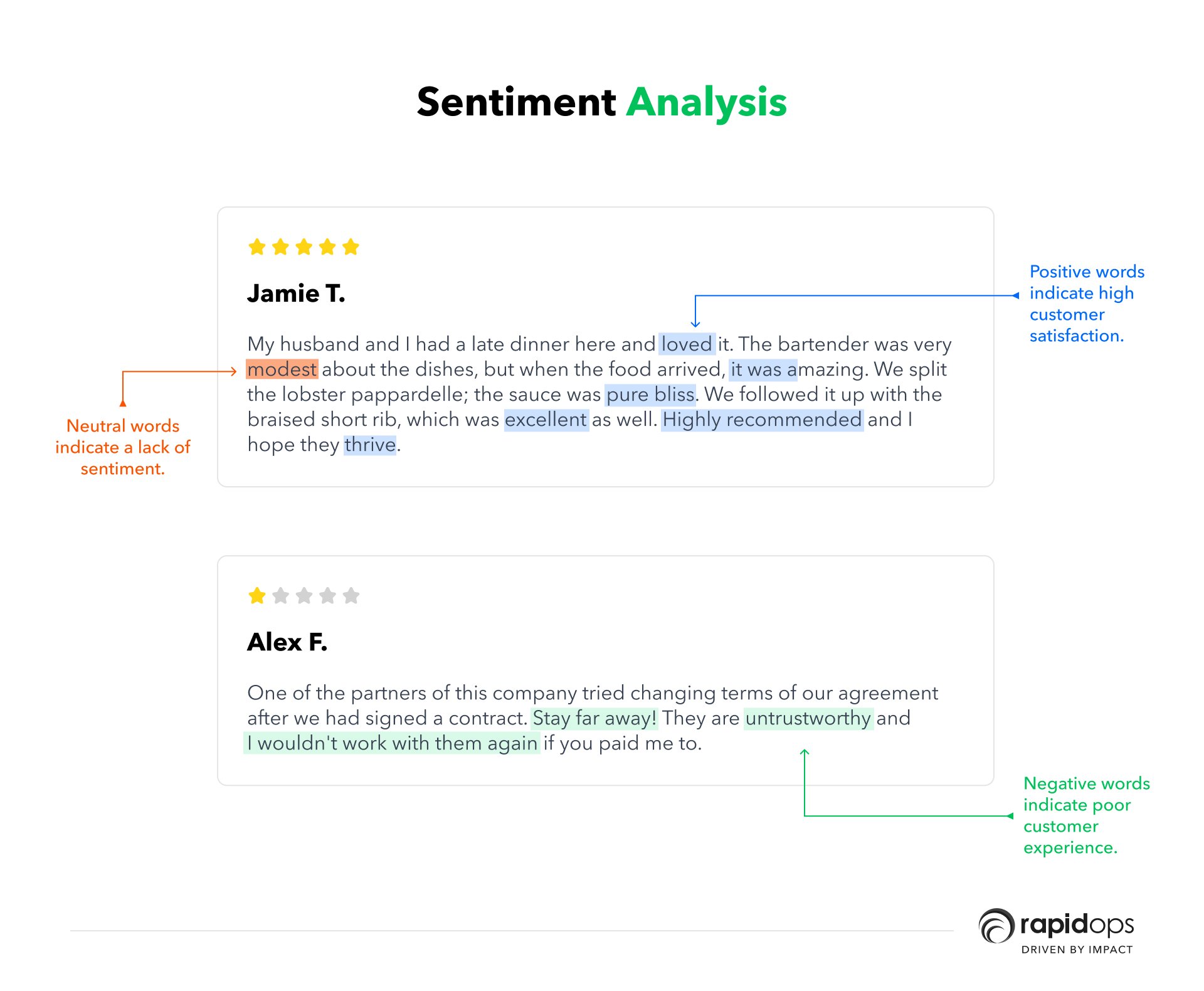
A new conversational IVR system (Interactive Voice Response system) employs AI to handle time-consuming and repetitive activities with automated routing, making simple customer conversations and other necessary transactional activities more efficient.
From taking the time to authenticate users with voice biometrics to instructing the IVR system directly in natural language, improving customer experience is becoming increasingly more manageable thanks to AI-backed IVR systems.
4. AI in finance
Personal finance apps like Intuit Mint or TurboTax disrupt financial institutions using Artificial Intelligence (AI) to provide customer assistance and advice.
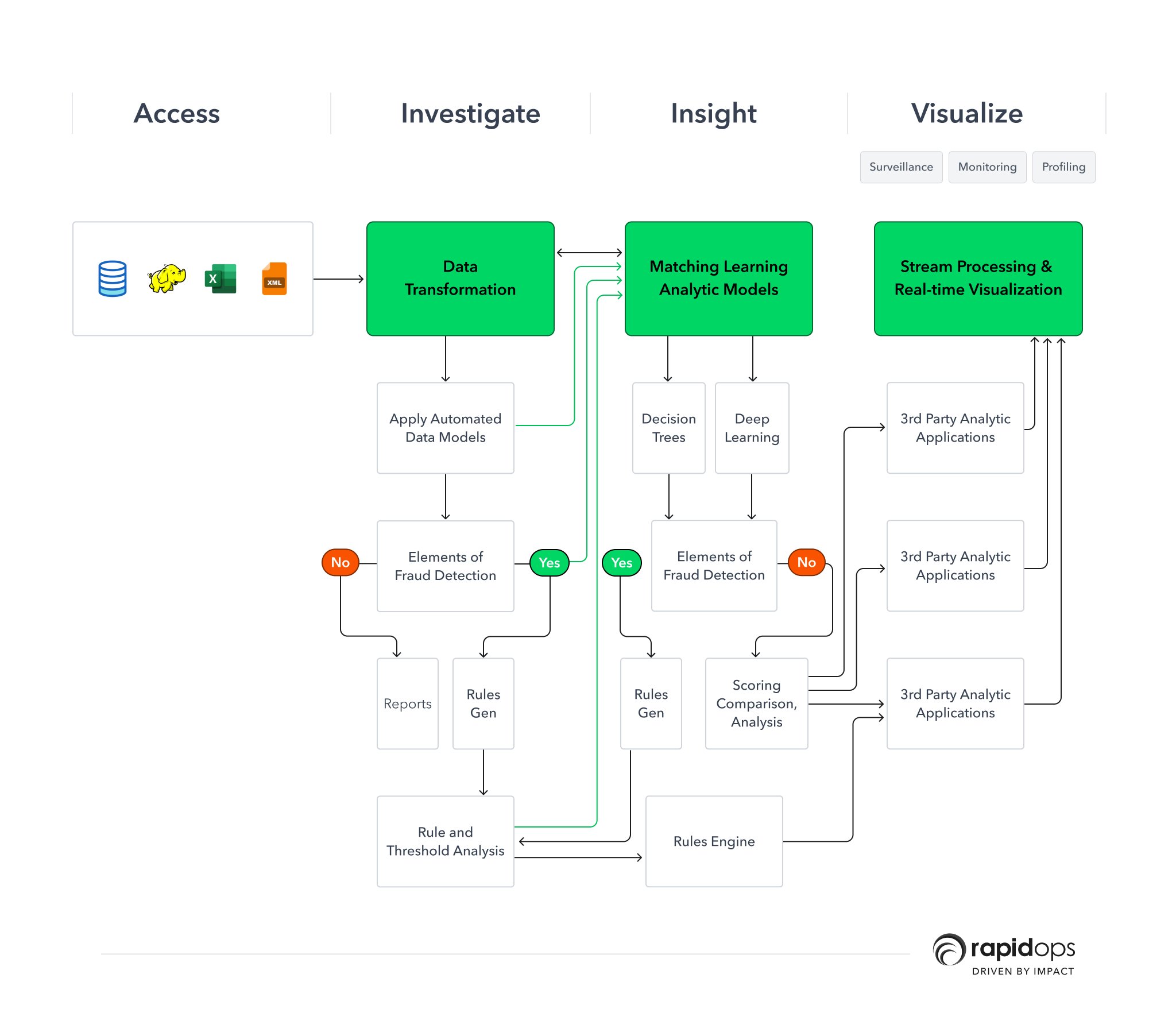
Banks successfully employ chatbots to inform their customers about products and services. Virtual assistants are being used to cut costs and improve compliance with banking rules.
AI is also applied to banking to make credit decisions, establish credit limits, find investment possibilities, and detect fraud.
5. AI in healthcare
AI is being used to provide an analysis of a surgeon's technical abilities. Doctors use AI to assist in medical diagnoses and make more informed treatment decisions.
The system uses machine learning algorithms to analyze patient data, including medical history, lab results, and imaging scans. The AI system then suggests probable diagnoses to the doctors based on the information fed into its system.
Accurate and timely diagnoses will lead to improved patient outcomes and will also reduce overall healthcare costs.
6. AI in cybersecurity
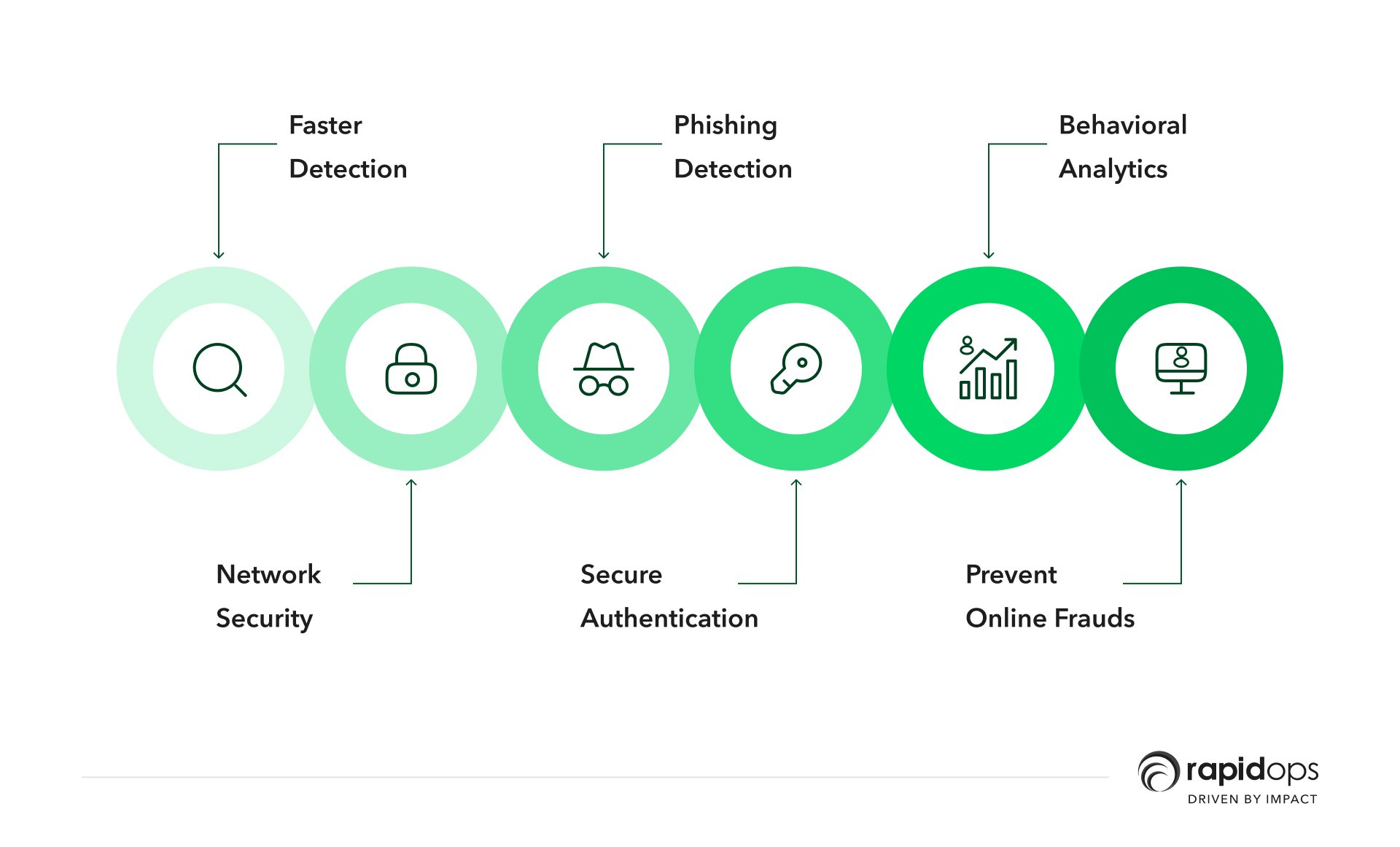
Organizations use machine learning in security information and event management (SIEM) software and related areas to detect anomalies, identify suspicious activities, and indicate threats.
The maturing technology plays a significant role in helping organizations fight cyber-attacks.
7. AI in education
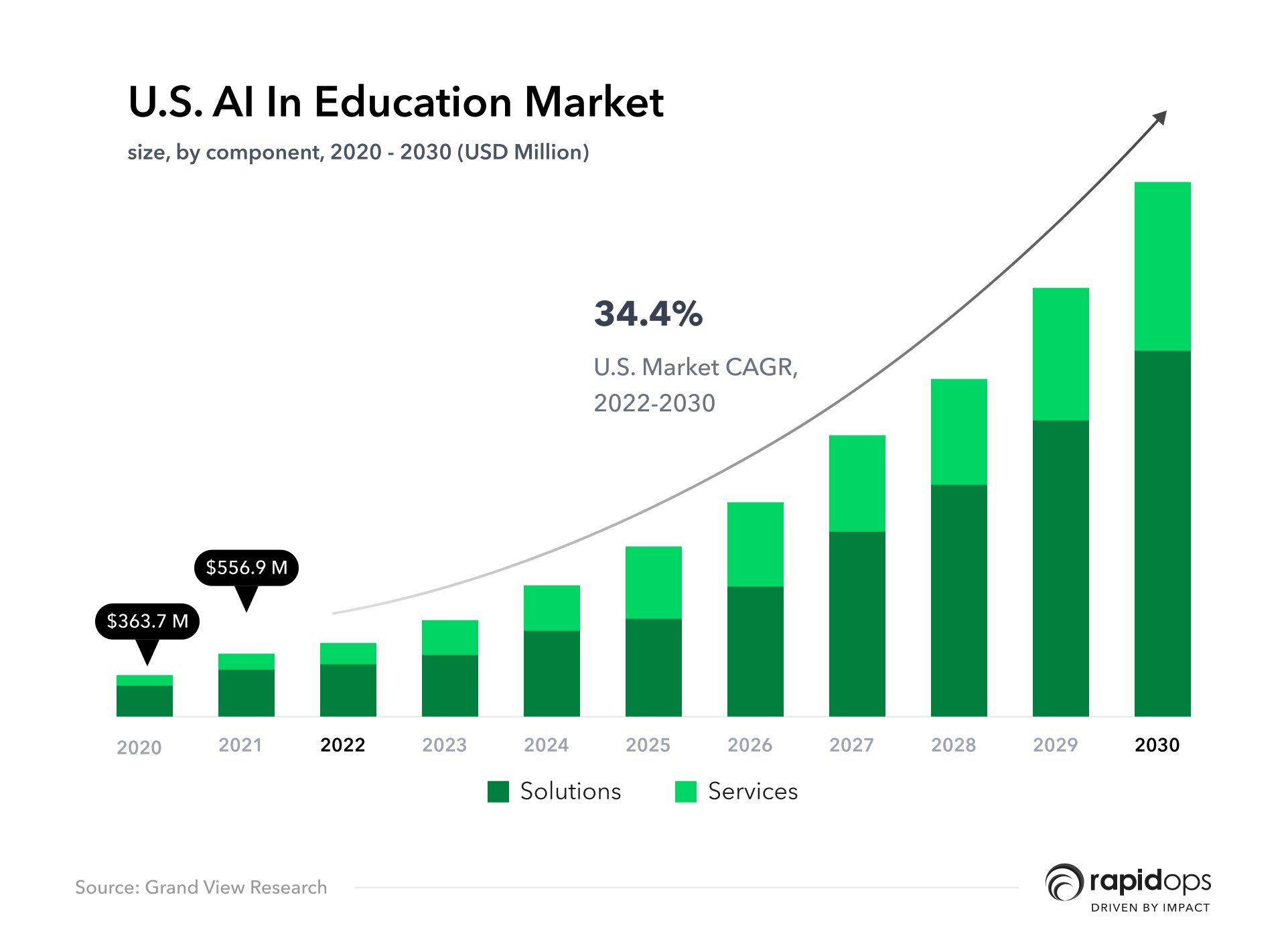
AI may be able to grade automatically, allowing teachers more time to focus on other things. It can evaluate and adapt to the needs of learners, allowing them to work at their own pace.
What are the things you should consider while applying AI in your business?
There is no easy answer regarding applying AI in your business. On one hand, several benefits can be gained from employing it. On the other, you must consider some of its downsides too.
Application or indulgence with AI broadly depends on the specific circumstances and your organizational objectives.
Ethical implications of AI
AI can assist in efficiency and decision-making by allowing you to make better and quicker decisions. However, if you're concerned about your privacy or making ethical choices, you should tread carefully.
Here are some broad principles to bear in mind:
- When dealing with delicate data, such as personal information or health records, you must exercise caution when employing AI.
- Have a strategy in place for safeguarding users' privacy.
- You should be careful when making judgments that could influence people's lives, such as who gets hired.
- AI can be a valuable tool while working on a project with a tight deadline.
- AI may not be the best alternative if you're working on something that requires creativity or intuition (as of now).
In general, using AI thoughtfully and responsibly is critical. You must be cautious about the potential dangers but should also be intrigued by the possibilities. With the appropriate strategy, AI may be a potent tool for improving your business and gaining better momentum in your industry.
How should you plan and execute an AI project?
AI projects are frequently built on top of existing software or internal company systems, adding a minor or more notable AI-powered feature to maximize the impact of the organization’s collected and integrated data.
It is crucial to have a strategy for the necessary resources, tools, budgets, and knowledge to calculate an AI project's cost.
FAQs on estimating an AI project
Let's answer some questions related to the development of AI projects.
Q1. What should I do first?
This is the most common inquiry for those unfamiliar with AI projects. The solution is straightforward. Start by establishing a more explicit business goal and determining the project's viability and future return on investment.
To do so, decide the fraction of your processes that need AI implementation and then rate them based on their priority. Once you have done that, you must decide on the data sources required for training the AI/ML models.
Once you have covered data procurement, you must understand the time and talent required to complete your AI project.
Q2. Should I work with internal resources or hire a technological partner to create an AI project?
When considering whether to hire a technological partner to create an AI project, there are several factors to consider. Here's what you need to know:
1. Expertise
Creating an AI project requires specialized skills and knowledge. Look for a technological partner with experience developing and deploying AI solutions in your industry.
2. Available resources
Developing an AI project requires significant resources, including time, money, and computing power. Look for a technological partner who can provide the resources needed to complete the job and ensure the cost is within your budget.
3. Scalability
Look for a technological partner who can provide the necessary resources and expertise to scale the project as needed. Ensure they have experience developing scalable solutions that can grow with your business.
4. Cost
Consider the cost of developing an AI solution internally versus hiring a technological partner. Look for a partner who can provide a cost-effective solution without sacrificing quality.
5. Time-to-market
Look for a technological partner who can deliver the project within your timeframe. Ensure they have a track record of delivering projects on time and within budget.
If your company's resources, abilities, and expertise are limited, you may consider working with a technological partner to implement an AI strategy. Rapidops has been working with companies for years transforming business operations and helping meet mission-critical goals through advanced technologies. Learn more about working with a trusted digital partner here.
Q3. What is the average cost of an AI project?
There is no simple answer to this question since the cost is typically determined on an ad-hoc basis, as every business has its own AI requirement.
Conclusion: Why AI now?
Our question to you is, why not!
AI can help businesses enhance their customer service and better target the marketing efforts. And we are hoping that this guide would have answered some of the most crucial questions business owners might have o their mind while thinking about AI implementation.
In conclusion, artificial Intelligence has become an indispensable tool for businesses to achieve operational efficiency and make informed decisions.
AI offers a competitive edge to businesses with its ability to:
- Automate tasks
- Analyze large amounts of data
- Perform tasks at a speed and accuracy beyond human capabilities
According to research, financial success may be challenging to achieve if the talent and infrastructure for AI development are not in place. Implementation of AI comes with its own set of challenges, such as securing data and optimizing storage. However, the benefits it brings to the table far outweigh these challenges.
As AI matures and impacts industries, decision-makers and C-level executives are encouraged to adopt this technology and harness its potential to drive growth and success for their organizations.
By leveraging AI, machine learning, and data analytics, businesses can revolutionize their operations and stay ahead of the curve in today's fast-paced, data-driven world. If you want to understand how to ideate AI model deployment, its framework, and the technology stack involved, or get an estimate of your AI project, book your free discovery call with us today.
What’s Inside
- What are AI, ML, and Deep Learning?
- Why is artificial intelligence critical for your business?
- Unlocking the power of AI: An overview of how it works
- How to get started with developing your artificial intelligence solution?
- Critical aspects to monitor and assess for optimal AI solution performance
- What are the benefits of Artificial Intelligence?
- What are types of artificial Intelligence?
- Disrupting the debate: Are artificial intelligence and machine learning the same?
- Challenges in AI adoption
- What are the use cases of AI in different industries?
- What are the things you should consider while applying AI in your business?
- How should you plan and execute an AI project?
- Conclusion: Why AI now?




